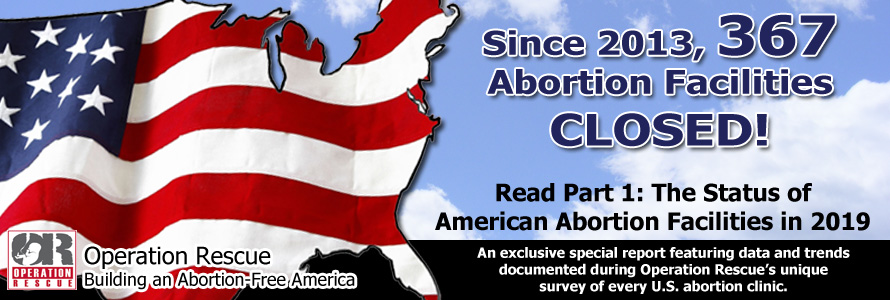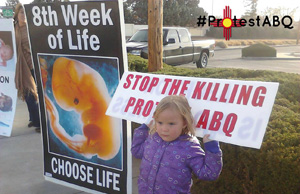The Status of American Abortion Facilities in 2019: Operation Rescue’s annual survey shows that overall, abortion facility numbers tick up
PART ONE OF A TWO-PART OPERATION RESCUE SPECIAL REPORT
By Cheryl Sullenger
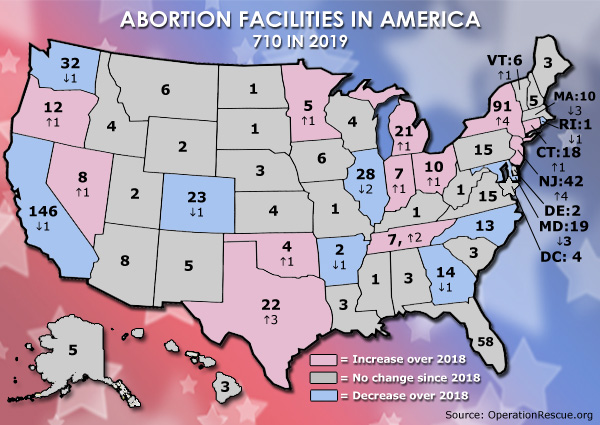
A total of 36 abortion facilities closed nationwide in 2019, according to a survey of every abortion facility in the U.S. conducted by Operation Rescue.
While the number of closures shows that in certain areas, abortion suppliers have outstripped the demand, as abortion numbers and rates continue to drop nationwide, according to the Center for Disease Control.
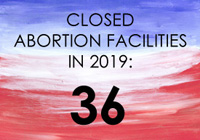
Other noteworthy facts were revealed by Operation Rescue’s survey.
- Since 2013, 367 surgical abortion facilities have permanently closed.
- This year’s closures represent a staggering 79 percent drop in the number of surgical abortion facilities nationwide since 1991, when there were 2,176 surgical abortion facilities.
- There was a net gain of nine U.S. abortion clinics in 2019.
- Planned Parenthood doubled down as a supplier of abortion-inducing drugs by opening five new pill clinics, dropping surgical abortions from five others, and adding chemical abortion availability to 14 of its centers that previously did not conduct abortions.
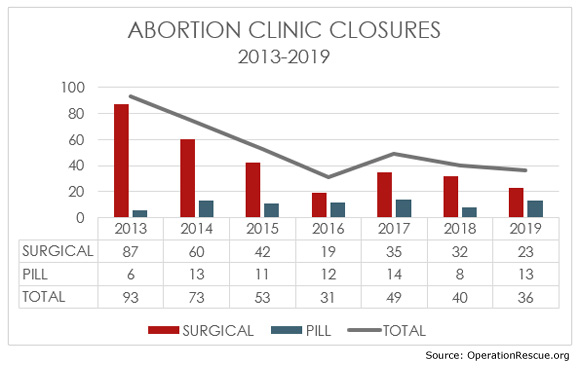
Methodology
Each year, Operation Rescue conducts a nationwide survey that involves contact with each abortion business in the U.S. The information gathered about the abortion clinics and their practices represents the most accurate data available.
This most recent data was compiled by Operation Rescue, which conducted a survey of all abortion facilities in the U.S. from November 18 through December 6, 2019.
Operation Rescue defines “abortion clinics” as those businesses that conduct abortions outside a hospital setting. There are two categories of abortion clinics:
- Surgical Abortion Clinics: These offices conduct surgical abortions. Almost always, surgical facilities also distribute abortion-inducing drugs.
- Medical Abortion Clinics: These offices supply abortions through the administration of drugs (pills) or other chemical means. They do not conduct surgical abortions.
Abortion facility totals
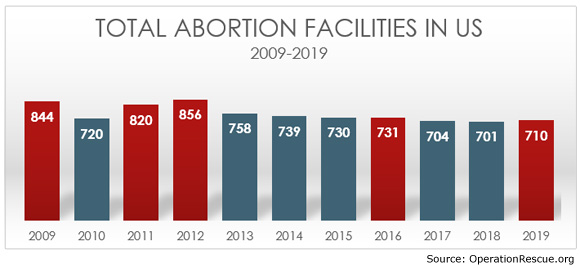
Today, there are a total of 710 U.S. abortion facilities, up nine facilities from 2018’s record low of 701.
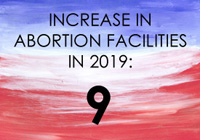
In 2019, new abortion facility openings slightly outpaced closures.
However, the number of surgical abortion clinics continues to decline with seven fewer today than last year at this time, hitting a record low of 464.
In fact, the number of surgical abortion clinics has fallen each year for at least the past decade from 713 in 2009 to just 464 in 2019. That represents a decrease of 35 percent over the last ten years.
“The decline in surgical abortion facilities is terrible news for the Abortion Cartel, but great news for women and their babies,” said Troy Newman, President of Operation Rescue. “Surgical abortion facilities are still the most profitable, especially if they conduct abortions past the first trimester when prices – and profits – really soar. When they shut down it saves lives and takes money out of the pockets of the abortionists.”
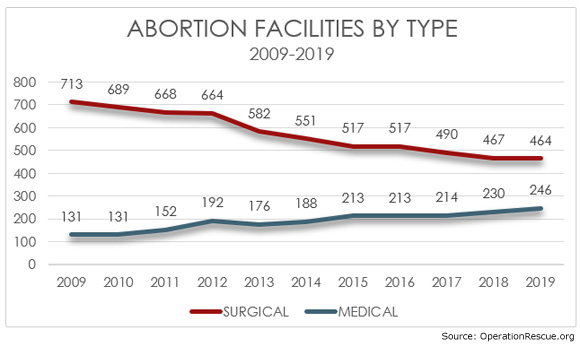
But when it comes to medication abortion facilities that are dispensaries for abortion-inducing drugs, those clinic numbers have steadily increased.
Today, there are 245 abortion pill facilities – an increase of 16 clinics nationwide in 2019.
Medication abortion facility numbers have been steadily on the rise over the past decade, increasing 47 percent in the past ten years.
Notable Closures
Clinic Latina, Phoenix, Arizona — It’s likely that most people have never heard of the Clinic Latina in Phoenix, Arizona, but its abortionist, Ronald Yunis, made news October 10, 2019, when he was arrested on outside another facility where he also conducted abortions, the Acacia Women’s Center. Pro-life activists had taken video of Yunis pulling a gun on one activist as he left the clinic’s driveway. Police investigated and later arrested Yunis. It was after his arrest that the Clinic Latina stopped conducting abortions.
San Diego Women’s Medical Clinic, San Diego, California – This facility owner, Michael Wong, who conducted abortions over the better part of four decades, finally stopped in 2019.
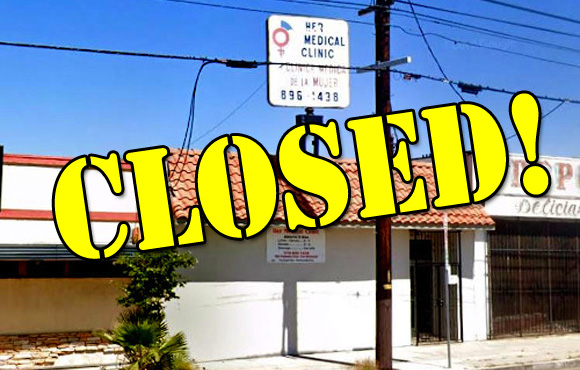
Her Medical Clinic, Pacoima, California – After years of pro-life outreach at this run-down abortion mill, Her Medical Clinic has finally closed. Operation Rescue’s staff has memories of public outreach at this facility and praying for its closure dating back over twenty-five years.
American Women’s Services affiliates in Baltimore, Cheverly, and Silver Spring, Maryland – These three chemical abortion facilities were owned by the disgraced New Jersey abortionist Steven Chase Brigham. The reason for their closure is cloaked in mystery. These facilities once conducted surgical abortions, but were halted from continuing to do so in 2013, after it was discovered that they were illegally administering misoprostol to women without a licensed physician present. The Baltimore facility was the site of the death of Maria Santiago, 38, who stopped breathing, then suffered cardiac arrest after an abortion on February 13, 2013. No one at the clinic, including abortionist Iris E. Dominy, had current CPR certification. A crash cart in the hallway was not used and the defibrillator was broken.
States
This year, Rhode Island became the seventh state with just one abortion facility. Those seven states are Kentucky, Mississippi, Missouri, North Dakota, Rhode Island, South Dakota, and West Virginia.
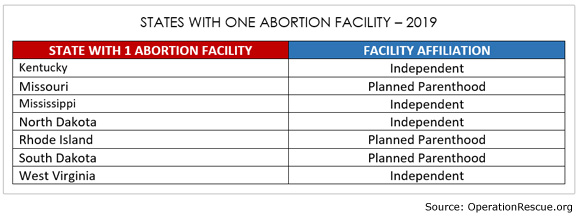
In all of those states, the last open clinics are surgical abortion facilities. Three are operated by Planned Parenthood, while the other four are independent abortion businesses.
Abortion clinic numbers increased in twelve states over the past year, while there were fewer abortion facilities in nine states. Thirty states, including the District of Columbia, had no net change in the number of abortion clinics. (See map above.)
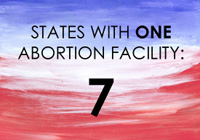
The states with the largest increase in abortion clinics were New York and New Jersey, which both added four facilities. This is likely due to the liberalization of abortion laws – including the repeal of safety regulations – in those two states.
There were nine states in which abortion facility numbers decreased. The states with the largest decrease in abortion clinics were Massachusetts and Maryland, where both states’ clinic totals fell by three facilities. Financial considerations appeared to have caused the decrease in Massachusetts, while in Maryland, three abortion pill clinics operated by the disgraced New Jersey abortionist Steven Chase Brigham inexplicably halted operations.
In Kansas City, Kansas, Planned Parenthood Great Plains was thwarted from opening a new surgical abortion facility when the pro-life group Planned Parenthood Exposed, led by local activist Ron Kelsey, persuaded a landlord to cancel a signed contract with Planned Parenthood.
Planned Parenthood
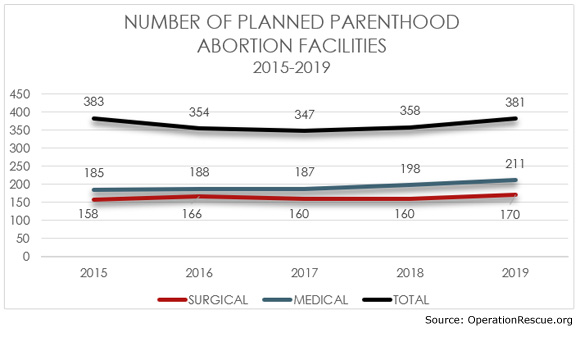
Of the 710 abortion facilities currently open for business, 381, or 54 percent, are Planned Parenthood facilities. Planned Parenthood operates 170 surgical abortion facilities and 211 medication abortion-only clinics – the vast majority of that type of facility currently in operation.
In all, Planned Parenthood opened 21 new abortion sites in 2019. Three were surgical abortion facilities while 18 were “new” medication abortion clinics. Of those eighteen, 14 were existing referral clinics that added abortion drug availability.
While Planned Parenthood operates more facilities than independently owned clinics, it is the independent clinics that still conduct the most abortions, according to a report published by the Abortion Care Network.
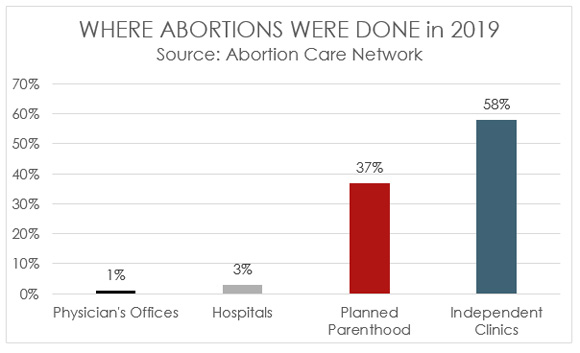
That report claims that Planned Parenthood conducts 37 percent of abortions in the U.S. while independent clinics conduct 58 percent — with fewer facilities. However, when compared to 2018 figures from the same source, this indicates that Planned Parenthood gained two percent of the total abortion market share in 2019.
Despite Planned Parenthood’s modest growth in 2019, there are still seven states that have no Planned Parenthood abortion facility.
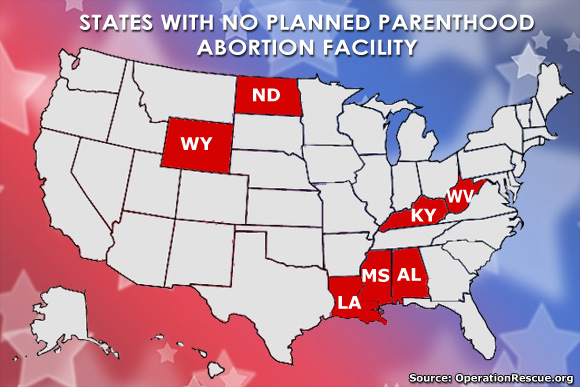
Impact of state legislation

In all, nine states passed pro-abortion legislation in 2019.
Those states include California, Hawaii, Illinois, Maine, Nevada, New Jersey, New York, Rhode Island, and Vermont.
Of the nine states, three states experienced an increase in abortion facilities three states recorded a decrease due to a rise in the number of medical abortion facilities. Three states saw no change.

It usually takes time for legislation passed on the state level to have an impact, especially if the enactment of new laws are delayed by challenges in court, as is the case with most pro-life legislation.
However, New York’s new abortion law that eliminated safety regulations and reduced clinic accountability had an immediate impact that was perhaps unexpected by state lawmakers.
“The impact of these pro-abortion laws so far has been an increase in the number of botched abortions that require ambulance transport from abortion facilities. These laws are lowing safety standards and, in turn, hurting women in order to increase abortion profits for chains like Planned Parenthood,” said Newman.

That is particularly true in New York where, for example, Planned Parenthood’s flagship abortion facility, the Margaret Sanger Planned Parenthood in Manhattan has increased the number of known calls for ambulance transport from three in 2018 to thirteen in 2019.
On the other hand, 17 states passed pro-life laws in, 2019, but with most of the new laws tied up in legal challenges, including gestational abortion limits in nine states.
Those states include Alabama, Arkansas, Georgia, Idaho, Indiana, Kentucky, Louisiana, Mississippi, Missouri, Nebraska, North Dakota, Ohio, Oklahoma, South Dakota, Tennessee, Utah, and Wyoming.
Out of those states, all but five saw no change in the number of abortion facilities.
Nevertheless, pro-life legislation passed in previous years continues to contribute to clinic closures and is providing necessary road-blocks to keep the rapid expansion of abortion chains in check nationwide.
Protect Life Rule
In a significant move, the Department of Health and Human Services enacted the Protect Life Rule in the spring of 2019, which prevents clinics that conduct or refer for abortions from receiving Title X family planning grants. It is estimated that this rule will deprive Planned Parenthood of $60 million annually in taxpayer funding.
At least four states have stepped in to replace the Title X grant money from their state coffers. Those states are Illinois, New Jersey, New York, and Vermont. The cities of Austin, Texas, and New York City gave a total of $400,000 to keep abortion facilities open.
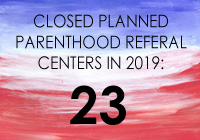
Nevertheless, the Protect Life Rule may have been at least partially responsible for the closure of 23 Planned Parenthood centers that did not conduct abortions. That has the benefit of reducing Planned Parenthood’s reach and ability to market abortions into communities where those referral clinics no longer exist.
What’s behind the increase in chemical abortions?
The rise in the number of abortion facilities in 2019 is attributable to several factors, including an effort by abortion businesses to increase sales of abortion drugs, which are easier and cheaper to offer than surgical abortions.
Other abortion chains, including Carafem, the Texas-based Whole Women’s Health, and the California-based FPA Women’s Health have expanded their clinics that only offer abortion drugs.
Planned Parenthood has continued to expand into the chemical abortion business in three ways.
- Conversion of 14 referral centers into abortion pill dispensaries.
- Slowly expanding webcam abortion services into areas where they are still allowed. (They are restricted or banned in 20 states).
- Experimenting with a new scheme in the Pacific Northwest and elsewhere to distribute abortion drugs through the U.S. Postal Service with the assistance of a smart phone app, as Operation Rescue’s research earlier this year explains. Currently that app is not available to the public.
Earlier this year, Planned Parenthood introduced a smart phone app to the public that can be used to obtain birth control pills. It is possible that at some point, Planned Parenthood will be able to use that platform to distribute abortion drugs through the mail, as their experimental program seems to indicate.
This is a matter that requires vigilance and new, proactive legislation to protect women and babies as Planned Parenthood aggressively seeks new ways to expand abortion nationwide.

As Operation Rescue reported in an exposé earlier this year, there is a huge profit margin in providing abortion drugs. Planned Parenthood pays about $82 for the mifepristone/misoprostol abortion drug combination, but sells them for a huge mark-up at an average of $604 at their abortion pill clinics around the country.
The profit margin for the app-to-mailbox scheme is even greater because women need not ever visit a Planned Parenthood clinic to obtain abortion-inducing drugs.
The pill-by-mail scheme would be one way to circumvent pro-life trigger laws that would ban abortion in many states should Roe v. Wade be overturned – something that appears likely should President Trump win re-election and/or be afforded additional Supreme Court picks.
Conclusions
Abortion businesses are desperately attempting to expand into untapped markets in order to stay solvent in a time when the overall demand for abortion has decreased. Profitable medication abortions have been the focus of this attempted expansion.
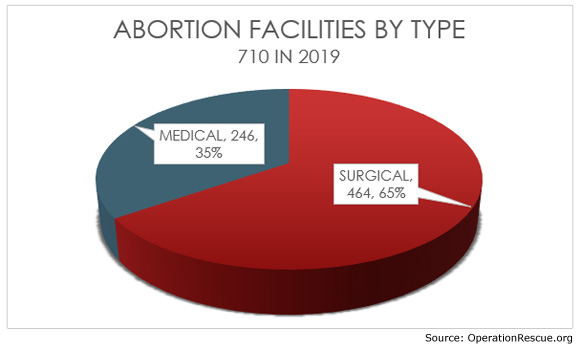
Operation Rescue’s survey found, however, that most clinics that only provide chemical abortions tend to be part-time facilities, whereas surgical facilities have more abortion days available. For example, the survey found that some abortion pill clinics are only open to dispense abortion drugs as infrequently as once a month.
Surgical abortion facilities, which tend to be busier clinics, require more overhead to operate and are more costly to staff and equip. That may explain why the number of surgical abortion facilities has fallen each year over the past decade while medication clinics have increased.
Clinic closures in 2019 were generally due to the following reasons:
- Financial problems.
- Abortionists who quit or retire and cannot be replaced.
- Pro-life legislation and/or activism.
- Criminal conduct and/or regulatory violations.
“Planned Parenthood received massive funding in 2019 through private donations and state and federal disbursements. This enabled it to dive headlong into the abortion pill market, expanding into twenty-one new locations,” said Newman. “However, that number would have been much worse, had it not been for tough pro-life legislation and vigilant activists all across the nation.”
Newman concluded, “The closer we get to ending abortion in America, the harder the Abortion Cartel will fight against our efforts. The increase in abortion facilities and attempts to use alternate methods of dispensing abortion drugs is an indicator that the Abortion Cartel has stepped up their game, sensing the end for them is near. Our side cannot afford complacency, especially as we enter a critical presidential election year that will determine whether our national policies favor greedy abortionists or the protection of babies in the womb. The outcome of that election – as well as the fate of millions of innocent lives that hang in the balance – will be up to us.”
Up next: The Status of American Abortion Facilities in 2019, Part 2, which will reveal trends in abortion costs, wait times, gestational age limits, and more.

